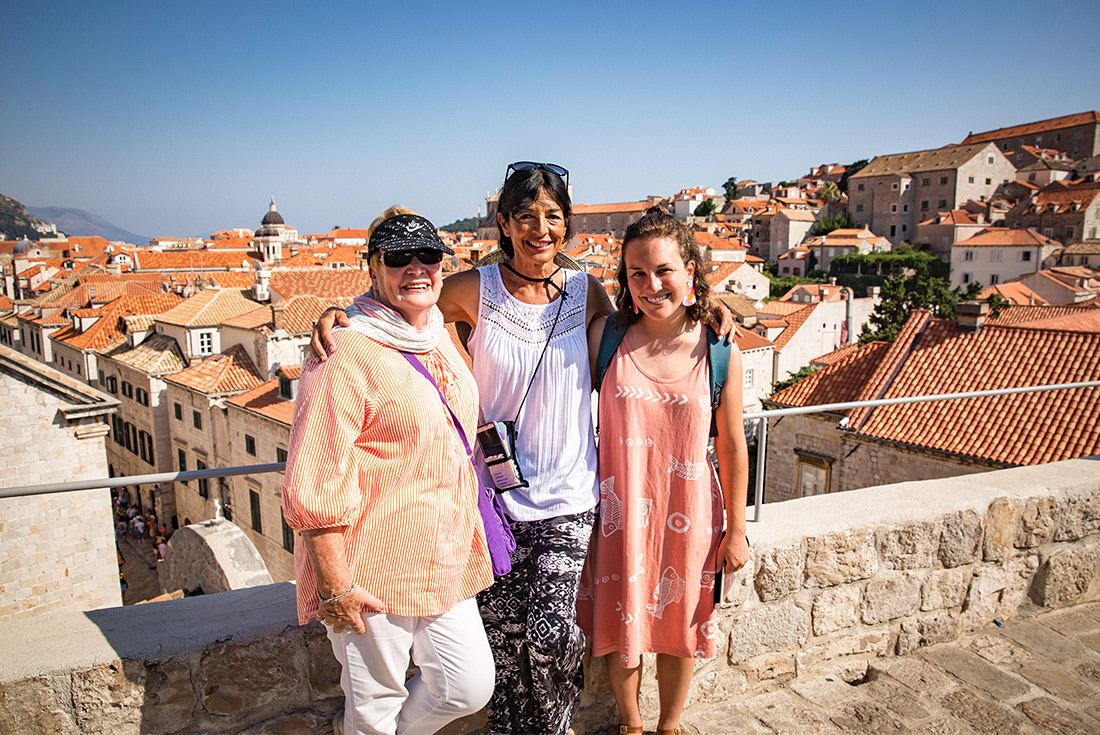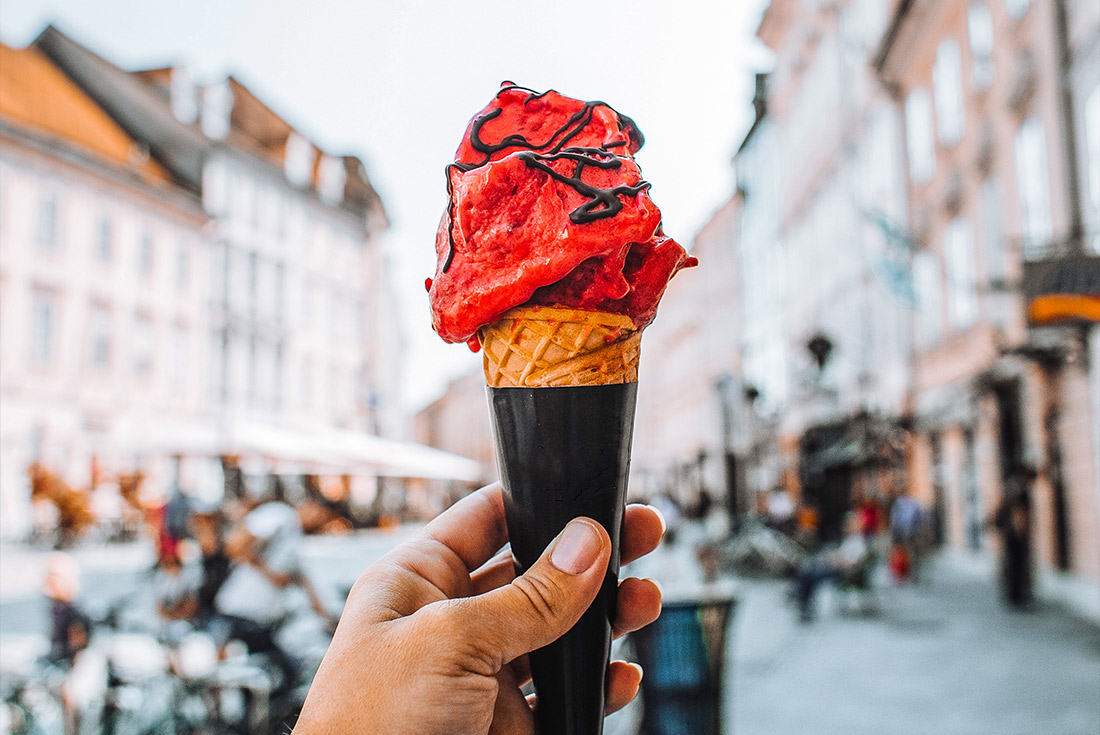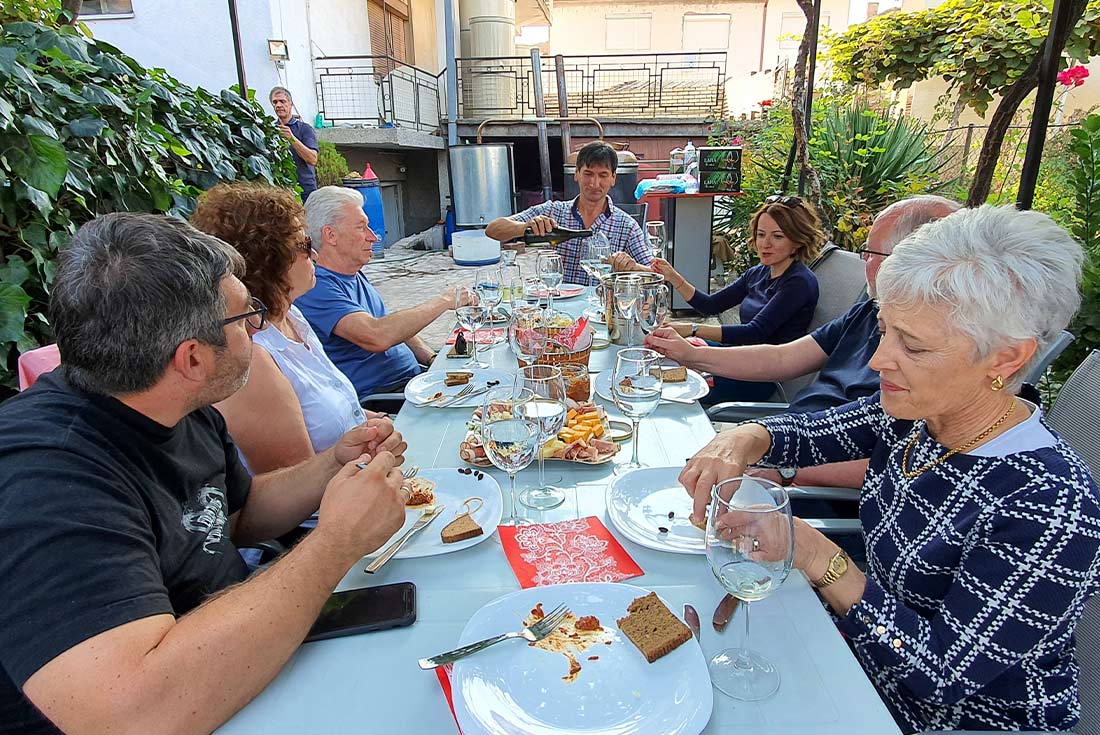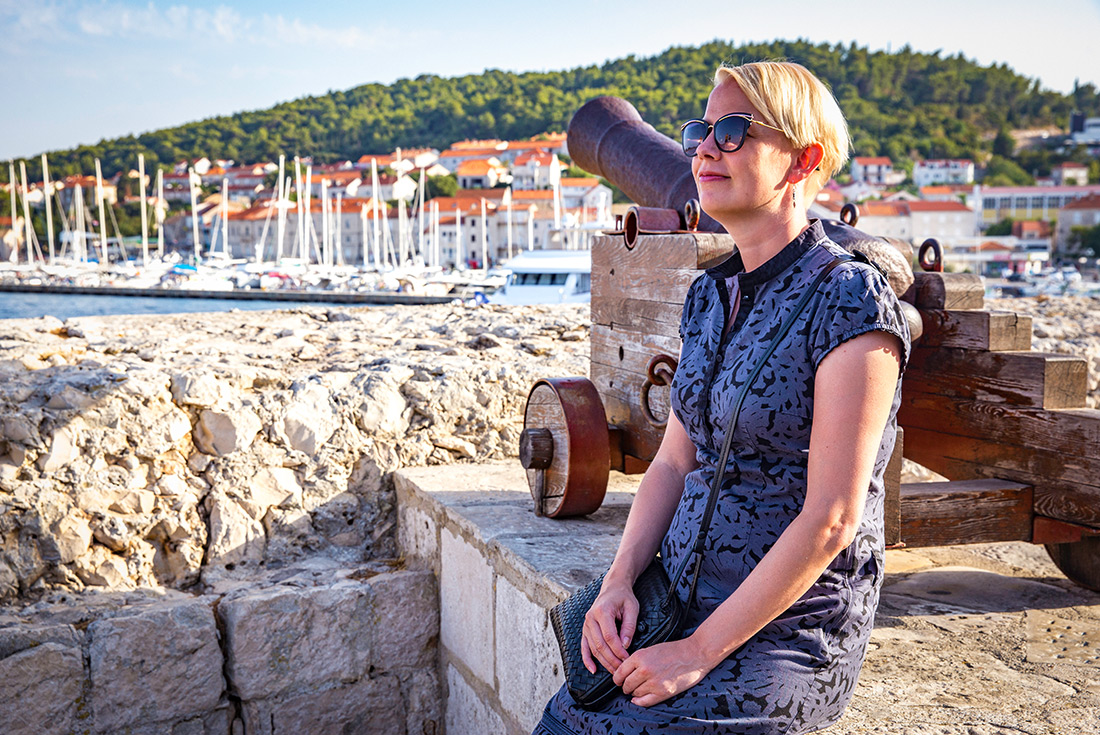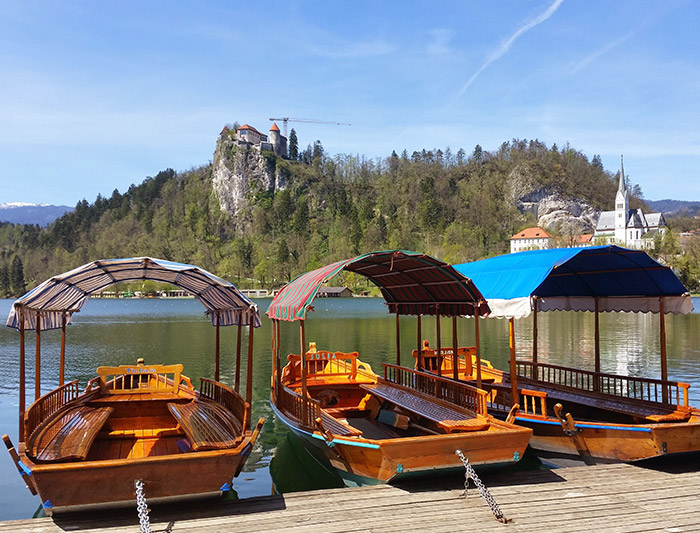SUMMARY
If it's a gourmet feast you want, a gourmet feast you shall get! This food inspired journey through the Balkans includes visits to salt pans, a truffle farm, wineries, waterfalls, national parks, fishing villages and so much more. Discover why Istria is considered one of the world's leading producers of quality olive oil, eat Dalmatian-style under a metal bell, raise a glass of Slovenian wine or plum brandy with your small group, and shout 'zivjeli!' to the simple, home-style cuisine this region is famous for. Indulge in a traditional barbeque in Kosovo, dine on home-grown produce in the private garden of a Dihovo family and visit a centuries-old olive press outside of Kotor. Experience next level hospitality on this unforgettable epicurean odyssey.
TOTAL DURATION : 21 Days
GROUP SIZE : MIN 1 MAX 12
TOUR ITINERARY AND DATES
START : Ljubljana
END : Skopje
COUNTRIES VISITED : Croatia,Macedonia, Republic Of,Montenegro,Slovenia,Kosovo
Validity : 01 JAN 2024 To 31 DEC 2024
Day :1
Location : Ljubljana
Zivjo! Welcome to Slovenia. Known as ‘Europe in Miniature’, Slovenia has a huge heart and a wealth of diversity. Best known for hearty, alpine stews, goulash and sauerkraut, Slovenia also boasts wonderful cakes and strudels, not to mention the culinary treasures found in the coastal Karst region, including teran (wine), prsut (air-dried ham) and sensational olive oils. Picturesque Ljubljana is the perfect spot to start your food-based odyssey, as it’s home to a surprisingly diverse food scene – think great local eateries, modern restaurants, street food, cafes and cake shops. Your adventure officially kicks off with a welcome meeting at 6 pm. After, your leader can suggest a great place in the heart of the city to sample some delicious traditional dishes.
Day :2
Location : Bled - Smartno
This morning, jump in your private transport and head off to the city of Bled. Tucked in the foothills of the Julian Alps, this resort town is home to the glacial Lake Bled, known for its picture-perfect landscape. When you arrive, hike up to the 11th-century Bled Castle, perched high on the edge of a cliff, and admire the 17th-century Pilgrimage Church of the Assumption of Maria, which sits on the island in the centre of the lake. There’s another drawcard that brings people from around the world to beautiful Bled – and that’s kremna rezina. Known as kremsnita by the locals, this dessert is a regional favourite, said to have been invented in Bled’s own Hotel Park in 1953 by Istvan Lukacevic, the in-house pastry chef. Traditionally presented in a perfect cube, this dessert is made up of two-thirds vanilla cream and one-third chantilly cream, sandwiched between layers of filo pastry. Sample some and see for yourself why this has become such an inherent part of the town’s experience. Hit the road again this afternoon, taking the scenic route to Smartno. In the west of Slovenia, and right on the Italian border, this spot is the perfect setting for an afternoon wine tasting. After indulging in some local drops with the group, you’ll have a free evening to explore the town.
Day :3
Location : Motovun
Today you’ll take a tour of an organic farm and orchard for an olive oil and dried fruit tasting. In the heart of the countryside of Slovenian Istria, you’ll learn the traditional methods of organic farming and low temperature drying, which helps preserve the unique flavours of the fruit that is grown on-site. Enjoy a range of hand-picked and dried fruits, including persimmons, figs, pears, plums and apricots. Leaving the farm, you’ll begin your journey south into Croatia, where your leader will pick the perfect place to stop for a picnic lunch. Enjoy local produce, including meats, cheeses, bread, jams and seasonal fruits and vegetables, while looking out over the landscape of the Istrian Peninsula that joins Slovenia and Croatia. After lunch, continue to Motovun in Croatia. Take the evening to explore and find the best spots to enjoy more local cuisine – your leader will always have the best recommendations.
Day :4
Location : Motovun
Motovun is one of the best-preserved medieval Istrian towns in Croatia, with houses scattered all over the hill and a spectacular view of Mirna River Valley. Walk the city walls this morning, enjoying the sprawling countryside views. Motovun Forest is the best place for hunting the famous Istrian truffle, and the nearby village of Livade is considered the truffle capital of Istria. Take a walk through the woods with an experienced truffle hunter and learn about this intriguing job. Perhaps even sniff out a truffle of your own! Your host will then prepare a brunch of fritaja (a traditional dish of eggs and truffles). Enjoy this local favourite paired with local sausages, cheeses, spreads and a delicious honey-topped cake. When you’ve had your fill, head off for the romantic Croatian town of Rovinj on the Adriatic Coast. When you arrive, go on a leader-led orientation walk to get your bearings and explore Rovinj's beautiful, architecturally intact Old Town. Through the centuries, Rovinj has enchanted countless artists and writers, including Jules Verne. Return to Motovun tonight and spend the evening at leisure. Maybe seek out a local restaurant to taste more of the fantastic local produce.
Day :5
Location : Plitvice National Park - Rakovica
Take a private transfer to the stunning World Heritage-listed Plitvice Lakes National Park – the largest national park in Croatia and known to be one of the oldest in southeast Europe, full of waterfalls and blue lakes. The waters tumble from a high, tree-lined ridge down through the valley before skirting dense forests of beech, spruce and pine. The Upper Lakes are in the dolomite cliffs, where rushing water weaves in and out of the karst before dropping dramatically down to the forest, grottoes and steep cliffs of the Lower Lakes. Take in this lush environment on a walk and boat trip through the park. After, carry onto Rakovica village, where you’ll stay the night. Dinner includes a delicious home-cooked meal provided by your hosts – a hearty serving of traditional Croatian kotlovina. This mixed meat dish consists mainly of pork schnitzels and sausages, traditionally made in a cauldron (which translates to kotlovina) for large groups of people, feasts, holiday celebrations or parties. Watch as your hosts prepare your meal before tucking in and enjoying the robust flavours and hints of spice.
Day :6
Location : Zadar
Farewell your hosts after breakfast, and then travel by to the walled city of Zadar. For centuries, Zadar was the capital city of Dalmatia, and you can feel the city's rich heritage in every step. It’s also celebrated for many culinary treasures, including the fresh seafood, the sheep and goats in the mountains, reared for their meat and milk, and the wonderful fresh produce grown in the broad belt of land surrounding Zadar. Before exploring this incredible city, visit a Benedictine nunnery, renowned for its fresh fruit and vegetables that are turned into delicious jams, pickles and preserves. Learn about the lives and work of the residents from your host, perhaps picking up some gardening or pickling tips along the way! After, you’ll have free time to explore the city. Be sure to stop by the ‘Sea Organ’ on Zadar’s waterfront – these musical steps celebrate the city’s relationship with the sea. Enjoy strolling the marble streets of the Old Town, discovering Roman ruins and medieval churches at your own pace. Your dining options are plentiful tonight – lamb in red wine, fresh fish or njoki – just ask your leader for their recommendations.
Day :7
Location : Split
Rise early this morning for a stroll through Zadar's vibrant fish market. The fish market is built into the city ramparts at the exact spot where the trawlers land with their catch. You’ll also get an opportunity to see some of the produce grown in the area this morning. Depending on the season, you may find citrus fruits and kiwis from the islands, fresh and dried figs and homemade olive oil. After, head southeast towards Split by public bus. After dropping your luggage at your hotel, head out of town to visit a local family who specialise in a regional delicacy – soparnik (a pastry made with a mix of silverbeet, onions and parsley). The family regularly provide these pastries for weddings and events, so you’ll be getting some of the best in the area! After your cooking demonstration, return to Split. Why not get together with your group for one last farewell drink to mark the end of your journey.
Day :8
Location : Split
After breakfast this morning, you’ll have the day to explore Split at your own pace. Sitting on a peninsula jutting out into the Adriatic Sea, Split is a jewel on the Dalmatian coast. Why not take a stroll along the Riva Promenade – a waterfront walkway that stretches between Split Harbour and the Marjan Forest Park. Spend some time in the park and take the walk to the top of the hill for some of the best views along the coastline and across the city. Prefer to soak up some city culture? Wander the streets of the Old City and learn the history of the city that once was the residence of a Roman Emperor. Looking for a light lunch or a snack? Get your hands on some fresh octopus salad or find a serving of soparnik. This evening there will be a meeting at about 6 pm to welcome any new travellers joining you on the next stage of your adventure. Afterwards, perhaps get to know your new food-loving travel buddies over an optional group dinner.
Day :9
Location : Split / Brac
Today, you’ll be hopping on a short ferry to take you to the Adriatic Island of Brac, just off the Split coast. Known for being the largest olive grove in Croatia (with over one million olive trees!), this small island is home to a range of delicious regional dishes. Spend some time strolling the streets and beach of the coastal town of Bol, before making your way to the small town of Skrip. Visit the olive oil museum, where you’ll learn about this extraordinary crop and be treated to an olive-themed selection of tapenade, cheeses, onion marmalade, anchovies, cured meats, salad, bread and wine. After lunch, enjoy a slice of hrapocusa – a layered cake of sponge and sticky sugared walnuts. This cake is so iconic to the island town of Dol that the Croatian Ministry of Culture has listed it as a protected item of intangible heritage. Sail back to Split for an evening at leisure.
Day :10
Location : Korcula
Wake up bright and early to explore Split’s Old City and the fish, fruit and vegetable markets. Wandering the historic city centre with your local leader, enjoy your last morning in this beautiful city before jumping on a ferry to the island of Korcula. Steeped in a long history of Greek, Slav and Roman settlers, Korcula’s Old Town is a tightly packed homage to the Renaissance architecture of Venice with plenty of narrow streets and squares for you to explore. What's more, the town boasts plenty of beaches to relax on if that's more your speed. Following an orientation walk with your leader, you might like to take a swim, walk around the bays and villages near Korcula town, pay a visit to the Marco Polo Tower, go shopping, or just soak up the ambience. Later, you’ll have the option to visit the tiny village of Pupnat in the interior of the island. Maybe have dinner in the village and enjoy a meal made entirely from local produce.
Day :11
Location : Korcula
The morning in Korcula is yours to enjoy. For a sweet start to the day, why not see if you can find some amareta (a local dessert with a crunchy outside and soft inside made of whipped egg whites, almonds and citrus zest) or some kalsuni (a crescent-shaped cookie made of buttery dough and traditionally filled with a nut-based stuffing). Relax into island life in the morning before heading to Zrnovo village for a hands-on cooking class in a local konoba – traditionally a tavern or wine cellar, konobas are now often popular restaurants where you can find the best of local Croatian cuisine. Today you’ll learn how to make zrnovo makaruni (a local hand-rolled pasta), before enjoying the fruits of your labour over lunch, paired with local wines. In the afternoon, return to Korcula town for some free time – beach, anyone?
Day :12
Location : Dubrovnik
Leaving Korcula behind, you’ll travel to Peljesac, a peninsula off southern mainland Croatia. Here, you’ll have the opportunity to sample what is considered some of the country’s finest local wines. Vineyards are scattered all along the peninsula, with the fertile soil in the region making for ideal growing environments. Here, you can find a wide range of wine varieties to tingle your tastebuds. Continue to the southern town of Ston and indulge in an oyster tasting and seafood lunch. This region is known to have the best seafood in Croatia and produces some of the best oysters in the world, so get ready for something special. Leaving Ston full and satisfied, make your way to Dubrovnik – the country’s iconic walled city. You’ll have the evening to explore the city at your leisure (maybe see how many Game of Thrones filming locations you can find!), before having the option to catch up with your group for a farewell dinner.
Day :13
Location : Dubrovnik
Enjoy a free day in Dubrovnik. With the sparkling water of the Adriatic in the background, Dubrovnik is picturesque, full of character and easily covered on foot. The next stage of your adventure begins with a welcome meeting at 6.30 pm today. After your important meeting, you could head out for a dinner to get to know your fellow travellers. Croatian cuisine varies between regions, but an unwavering favourite is the charcuterie. Traditionally created with pork, charcuterie involves using a lot of specially prepared meats, all of which showcase flavours specific to their preservation process. If the option’s there, why not give it a try?
Day :14
Location : Kotor
After breakfast, cross into Montenegro and visit the town of Njegusi, known around the country for its famous smoke-dried hams and cheeses. Stop at a smokehouse, where your leader will explain their production process, dating back for centuries, and will also take you for a tasting of their famous Njegusi smoked hams, cheeses and grape brandy. After, visit an olive farm in the village of Tici, located in the Lustica Bay area near Kotor. Discover the art of olive pressing as your hosts share their second-generation organic olive oil production techniques. Wander through the beautiful olive groves before arriving at an ancient stone olive mill, where olives were once milled by hand. A guided tasting will give you an insight into what makes for good oil. Back in Kotor, with free time later in the day, consider getting lost in the town’s crooked walkways, or perhaps climbing the hills behind the city to experience Kotor’s ruined fortification walls. With a free night, maybe have an optional dinner at a Kotor wine bar.
Day :15
Location : Prizren
Say goodbye to Montenegro and head to Kosovo. The first stop on the journey is Rozafa Fortress, Albania, one of the last strongholds of the allied Christian forces against invading Ottomans in the 15th century. In the afternoon, arrive in Prizren, the second largest city in Kosovo. This picturesque location remains the most culturally and ethnically diverse in all of Kosovo. The rest of the day is yours to explore Prizren at your own pace. The abundance of orange rooftops makes for an interesting sight, as do the impressive mosques and churches in the city. For dinner, perhaps ask your leader for some local restaurant suggestions.
Day :16
Location : Ohrid
Start the day with a guided tour of Prizren. Pass by the sights, smells and sounds of the bazaar, with a whole range of specialties on offer, including stuffed peppers, which are a big hit. After visiting the bazaar, continue to Pristina, Kosovo’s capital and largest city. Your leader will take you on another guided tour, exploring the city centre. A special experience then awaits with a delicious Kosovo-Serb barbecue, prepared by the local hosts who serve sausages and other pork delicacies from their personal smokehouse. Take some time to explore the surrounding Gracanica settlement and monastery. The area serves as the home of one of the few dominantly Serbian populations in Kosovo. After, leave Kosovo behind and travel into North Macedonia. Your first stop will be the St Jovan Bigorski Monastery (St John the Baptist), which is widely renowned as the most spiritual monastery in North Macedonia. Then drive onward to Ohrid where you will spend the evening.
Day :17
Location : Ohrid
Ohrid is Europe’s oldest lake and, as one of the oldest human settlements in the world, it’s got a wealth of historic sites and religious monuments to discover. The town is said to have once been home to 365 churches, one for each day of the year, earning it the nickname ‘the Macedonian Jerusalem’. Today is free for you to explore the town’s streets and churches, maybe picking up a bargain or two in the vibrant Old Bazaar. Alternatively, consider joining your leader for an optional day trip to Ohrid Lake and the mystical Sveti Naum Monastery – one of the most important places of pilgrimage in North Macedonia. Take in the ancient Tzar Samoil’s Fortress, which stands on the top of Ohrid Hill and looks across the town, along with a 2000-year-old Roman theatre that was uncovered near its upper gate. The Sveti Jovana Kaneo church, which sits on a rocky outcrop overlooking the lake, is one of the most popular in North Macedonia. This evening, head to Kuratica – a village on the outskirts of Ohrid. Here, you’ll experience local hospitality and enjoy a home-cooked meal. Your host also brews his own rakija, which you’re welcome to sample for a quick warm up of your insides!
Day :18
Location : Bitola
After leaving your accommodation in Ohrid, head down to the green market for a traditional breakfast. You might like to try the best burek in town or enjoy a gjomleze pie (a traditional dish made from an old Ohrid recipe). Drive onward to Lake Prespa, a beautiful area that’s popular with Macedonian holidaymakers. Here, you’ll visit a local apple farm and have the chance to taste some of the fresh produce yourself. Then, head to the little village of Dolno Dupeni on Lake Prespa, where you will be invited into a local home for a cooking demonstration and some lunch. Continue to Bitola and relax in one of the city’s many cafes or explore the stalls of the Old Bazaar.
Day :19
Location : Bitola
Today you’ll visit Dihovo – a small village sitting in the foothills of Mt Pelister. A local beekeeper will teach you about the honeybee and you’ll get hands-on with an open beehive demonstration. After, enjoy a tasting of honey extracted straight from the comb before having a home-cooked meal in a traditional villa. All the ingredients are organic and come from the family’s private gardens. Return to Bitola in the afternoon. Perhaps choose to take a guided tour of the ancient town and archaeological site of Heraclea Lyncestis, located on the outskirts of Bitola. Heraclea was founded by Philip II of Macedonia in the fourth century BC after he had conquered the surrounding region of Lyncestis. The city was named in honour of the mythological hero Heracles, whom Philip considered his ancestor.
Day :20
Location : Skopje
Start the day with a trip out to the Stobi archaeological site for a short walk. Stobi, once known as Paeonia, was conquered by the ancient kingdom of Macedon and became the capital of the Roman province of Macedonia Salutaris. Continue to Tikves wine district – the production of grapes is prominent in North Macedonia, thanks to an abundance of sunshine and rich, rocky soil. Today’s adventure offers a taste of local varieties at two of the country’s finest wineries. Enjoy a pairing of delicious local cheeses and cured meats next to these wines this afternoon. Arrive in Skopje in the late afternoon and take a guided walking tour of the centre city, tasting traditional Macedonian sweets along the way. Head out with your fellow travellers for a final dinner in Debar Maalo, the bohemian heart of Skopje. Your leader will ensure all your favourite dishes are ordered for one last celebration.
Day :21
Location : Skopje
With no activities planned for today, you are free to leave the accommodation at any time. That doesn’t mean your adventure has to end! If you wish to spend more time in Skopje or want to explore the fascinating Matka Canyon, just speak to your booking agent.
Reference : IT

